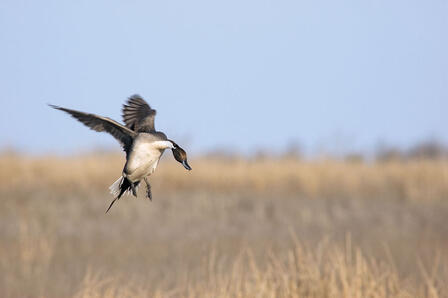DUCK POPULATIONS AT RECORD HIGHS

July 12, 2012
Trend continues for continent’s breeding ducks
WASHINGTON, DC — Although breeding habitat conditions have declined from previous years, the U.S. Fish and Wildlife Service’s (USFWS) 2012 "Trends in Duck Breeding Populations" report estimates breeding waterfowl numbers in North America's duck factory is at a record high. This year's estimate of 48.6 million breeding ducks is significantly higher than the 45.6 million birds estimated last year and 43 percent above the long-term average.
This annual report summarizes information about the status of duck populations and wetland habitats collected by wildlife biologists from the USFWS and the Canadian Wildlife Service for the “Waterfowl Breeding Population and Habitat Survey.” The survey samples more than 2 million square miles of waterfowl habitat across the United States and Canada.
Highlights from the survey in the northcentral United States, southcentral and northern Canada, and Alaska include the following population abundance estimates:
- mallard -- 10.6 million, a 15 percent increase over 2011 and a 39 percent increase over the long-term average of 7.6 million;
- gadwall -- 10 percent above the 2011 estimate and 96 percent above the long-term average;
- American wigeon -- 3 percent above 2011, but remains 17 percent below the long-term average;
- green-winged and blue-winged teal -- 3.5 million and 9.2 million, respectively, 20 percent and 3 percent above 2011 numbers. Both species continue to remain well above long-term averages by 74 percent and 94 percent, respectively;
- northern shovelers -- 5.0 million, 8 percent above 2011 and 111 percent above the long-term average;
- northern pintail -- 3.5 million, 22 percent below the 2011 estimate and 14 percent below the long-term average;
- redhead -- unchanged from last year but 89 percent above the long-term average;
- canvasback -- 0.8 million, 10 percent above last year's estimate and 33 percent above the long-term average; and
- lesser and greater scaup -- 5.2 million, 21 percent above the 2011 estimate and 4 percent above the long-term average.
Habitat conditions observed across the survey areas during the 2012 Waterfowl Breeding Population and Habitat Survey were characterized by average to below-average moisture, especially in the southern portions, due primarily to a mild winter and an early spring.
The 2012 survey's estimate of ponds for the northcentral U.S. was 1.7 million, 49 percent below the 2011 estimate of 3.2 million and similar to the long-term average. Significant decreases in wetland numbers and conditions occurred in the U.S. Prairies during 2012. Nearly all of the northcentral U.S. habitat was rated as good to excellent in 2011; however, only the habitat in the coteau region of North and South Dakota was rated as good in 2012, and no areas were rated as excellent habitat this year. Severe wetland declines in western South Dakota and Montana resulted in mostly poor to fair habitat conditions.
The annual survey guides USFWS waterfowl conservation programs under authority of the 1918 Migratory Bird Treaty Act. The USFWS works in partnership with state biologists from the four flyways – the Atlantic, Mississippi, Central and Pacific – to establish regulatory frameworks for waterfowl hunting season lengths, dates, and bag limits, derived in part from the data gathered through this annual survey. Using these frameworks as guides, the Kansas Wildlife, Parks and Tourism Commission will establish the 2012-2013 waterfowl seasons and bag limits at its August 23 meeting. The meeting will be conducted at the Kansas Wetland Education Center, 592 NE K-156 Highway, Great Bend, with the afternoon session beginning at 1:30 p.m. Waterfowl seasons will be discussed at the Public Hearing portion of the meeting, which will begin at 7 p.m.
-30-









